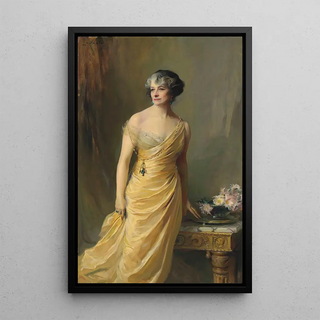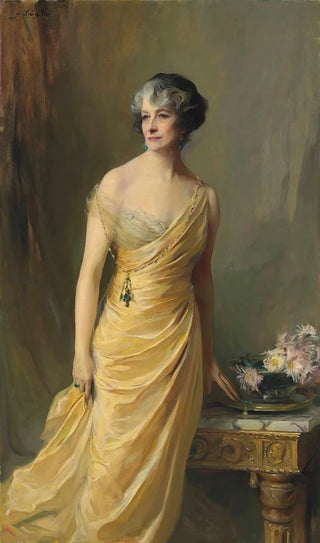Painting Lady Ludlow née Alice Sedgwick Mankiewicz - Philip Alexius de László | Art print


View from behind

Frame (optional)
Lady Ludlow née Alice Sedgwick Mankiewicz : a timeless elegance captured
The art print of Lady Ludlow, née Alice Sedgwick Mankiewicz, exudes an atmosphere of grace and dignity. The piece, created with a classic portrait technique, stands out with its soft colors and meticulous details. The shades of blue and cream envelop the subject, creating a visual harmony that invites contemplation. The artist manages to capture not only the external appearance of her model but also an inner essence, an emotional depth that transcends a simple portrait. Light plays a crucial role, accentuating the delicate features of the face and the texture of the clothing, offering an almost lifelike vision of this aristocratic figure.
Philip Alexius de László : master of portraiture at the turn of the 20th century
Philip Alexius de László is recognized as one of the greatest portrait artists of his time, having successfully blended tradition and modernity. Born in 1869 in Hungary, he was influenced by the great masters of the past while developing a personal style that allowed him to stand out. His work is part of a period when the classic portrait experienced a renaissance, particularly within European aristocracy. De László had the honor of painting many influential personalities, which attests to his importance in the art world. His ability to capture the personality and character of his subjects makes him an essential artist of the early 20th century.
A decorative acquisition with multiple assets
The art print of Lady Ludlow is a decorative piece that integrates perfectly into various spaces, whether an elegant living room, a refined office, or a calming bedroom. Its print quality and fidelity to the original work guarantee an aesthetic rendering that will appeal to art enthusiasts. By choosing this piece, you opt for a work that not only enhances your interior but also tells a fascinating story. The visual appeal of this canvas makes it a central decorative element, capable of inspiring admiration and initiating conversations around art and history.

Matte finish

View from behind

Frame (optional)
Lady Ludlow née Alice Sedgwick Mankiewicz : a timeless elegance captured
The art print of Lady Ludlow, née Alice Sedgwick Mankiewicz, exudes an atmosphere of grace and dignity. The piece, created with a classic portrait technique, stands out with its soft colors and meticulous details. The shades of blue and cream envelop the subject, creating a visual harmony that invites contemplation. The artist manages to capture not only the external appearance of her model but also an inner essence, an emotional depth that transcends a simple portrait. Light plays a crucial role, accentuating the delicate features of the face and the texture of the clothing, offering an almost lifelike vision of this aristocratic figure.
Philip Alexius de László : master of portraiture at the turn of the 20th century
Philip Alexius de László is recognized as one of the greatest portrait artists of his time, having successfully blended tradition and modernity. Born in 1869 in Hungary, he was influenced by the great masters of the past while developing a personal style that allowed him to stand out. His work is part of a period when the classic portrait experienced a renaissance, particularly within European aristocracy. De László had the honor of painting many influential personalities, which attests to his importance in the art world. His ability to capture the personality and character of his subjects makes him an essential artist of the early 20th century.
A decorative acquisition with multiple assets
The art print of Lady Ludlow is a decorative piece that integrates perfectly into various spaces, whether an elegant living room, a refined office, or a calming bedroom. Its print quality and fidelity to the original work guarantee an aesthetic rendering that will appeal to art enthusiasts. By choosing this piece, you opt for a work that not only enhances your interior but also tells a fascinating story. The visual appeal of this canvas makes it a central decorative element, capable of inspiring admiration and initiating conversations around art and history.






